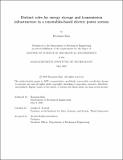Distinct roles for energy storage and transmission infrastructure in a renewables-based electric power system
Author(s)
Kim, Beomjun
DownloadThesis PDF (5.912Mb)
Advisor
Trancik, Jessika E.
Terms of use
Metadata
Show full item recordAbstract
Due to the intermittency of renewable resources, achieving a high coverage of renewable generation at low cost is one of the main hurdles to realizing zero-carbon electricity generation. In this study, we analyze the roles of energy storage systems (ESS) and transmission infrastructure in the cost-optimal deployment of a renewable electricity grid in the United States. We find that storage and transmission serve distinctly different functions: transmission is useful for addressing hours-long resource lows, but only plays a supplementary role in mitigating long-duration resource lows. Conversely, storage can handle both short-duration and long-duration resource lows. These different functions are driven in part by the large spatial footprints of the most extreme long duration resource lows. Furthermore, the total cost of renewable energy in the system and the cost-determining technological components in the system are dependent on the renewables penetration toward total demand—known as the energy availability factor (EAF). When the EAF is sufficiently low, the cost of a cost-optimized system is driven solely by generation costs. For low to intermediate EAF, both generation and transmission costs are dominant factors. At high EAF, generation and storage costs become the dominant factors.
Date issued
2025-05Department
Massachusetts Institute of Technology. Department of Mechanical EngineeringPublisher
Massachusetts Institute of Technology